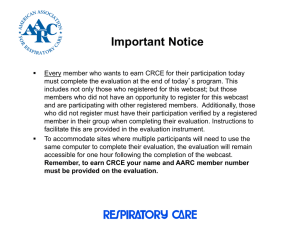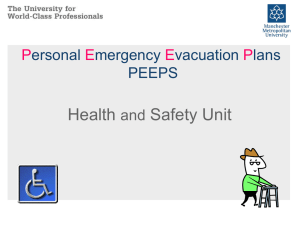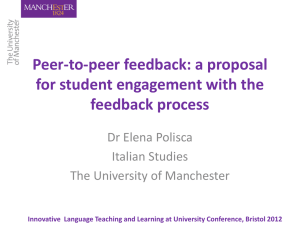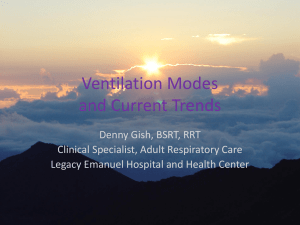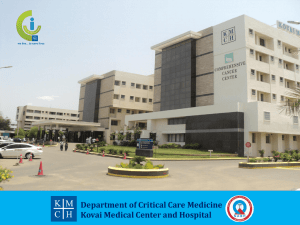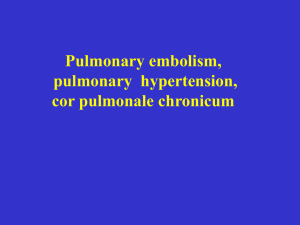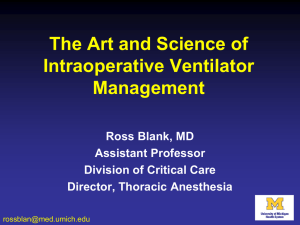Management of ARDs: Does it Apply to the OR?
advertisement
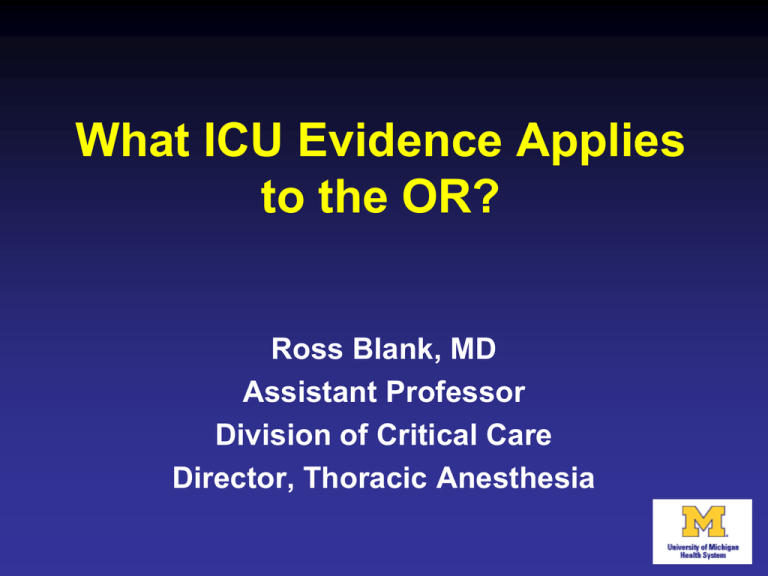
What ICU Evidence Applies to the OR? Ross Blank, MD Assistant Professor Division of Critical Care Director, Thoracic Anesthesia What We Do Anesthesia providers practice intensive care. • • • • • Airway Management Mechanical Ventilation Fluid Resuscitation Vasopressor Support Antibiotic Management What Works in ARDS? VENTILATOR MANAGEMENT What is ARDS? Definition formalized in 1992 American European Consensus Conference 1. Acute onset, bilateral infiltrates on CXR 2. PCWP ≤ 18 mmHg or no clinical evidence of left atrial hypertension 3. PaO2/FiO2 (P/F) Ratio ≤ 300 for ALI ≤ 200 for ARDS Bernard et al. AJRCCM 1994;149:818-824 What is ARDS? – Berlin Definition The ARDS Definition Task Force. JAMA 2012;307:2526-2533 Treatments of ARDS Non-pharmacologic Pharmacologic Low tidal volumes High PEEP Recruitment maneuvers Prone positioning High Frequency Oscillatory Ventilation (HFOV) Airway Pressure Release Ventilation (APRV) Conservative fluids Renal Replacement Therapy Early enteral feeding PA Catheter ECMO Corticosteroids Nitric oxide Alkali Therapy Neuromuscular blockade Ketoconazole Lisofylline Oxepa Antioxidants Neutrophil elastase inhibition Exogenous surfactant Liquid ventilation Inhaled β-agonists Statins Treatments of ARDS with Mortality Benefit Non-pharmacologic Pharmacologic Low tidal volumes (ARMA, NEJM 2000) High PEEP (meta-analysis, JAMA 2010) Recruitment maneuvers Prone positioning (NEJM 2013) High Frequency Oscillatory Ventilation (HFOV) Airway Pressure Release Ventilation (APRV) Conservative fluids Renal Replacement Therapy Early enteral feeding PA catheter ECMO? Corticosteroids? Nitric oxide Alkali Therapy Neuromuscular blockade (NEJM 2010) Ketoconazole Lisofylline Oxepa? Antioxidants Neutrophil elastase inhibition Exogenous surfactant Liquid ventilation Inhaled β-agonists Statins ARDSNet ARMA Trial RCT of 6 mL/kg vs. 12 mL/kg PBW Tidal Volume Further TV adjustments to maintain PPLAT < 30 cm H2O vs. < 50 cm H2O Ventilator Mode – Volume Control A/C PEEP/FiO2 per table in both groups 861 patients Mortality 31.0% vs. 39.8% (p = 0.007) NEJM 2000;342:1301-1308 Transpulmonary Pressure (PTP) Slutsky and Ranieri. NEJM 2013;369:2126-2136 PTP – Talmor Trial PTP – Talmor Trial • Calculated as difference between airway pressure and pleural pressure from esophageal balloon • Measured after endexpiratory and endinspiratory occlusions • After RM, adjust PEEP for goal PTP,exp 0-10 cm H2O, decrease TV to keep PTP,insp < 25 cm H2O Talmor et al. NEJM 2008;359:2095-2104 • On average, increased PEEP in experimental group (17 vs. 10 cm H2O) associated with increased PO2, improved compliance, lower FiO2, and modest increases in peak, plateau, and mean airway pressures • Control group generally had negative PTP,exp PTP – Talmor Trial Static Compliance = TV/(PPLAT - PEEP) The observation that PEEP increases were associated with more modest PPLAT increases demonstrates the improvement in compliance Talmor et al. NEJM 2008;359:2095-2104 Compliance Curve Best Compliance Compliance low: Atelectasis, Shunt Blanch et al. Curr Opin Crit Care 2007;13:332-337 Compliance low: Overinflation High VD/VT PTP – Talmor Trial • • • • Small trial (n = 61) Single center Unexpected signal of decreased 28-day mortality in experimental group Interestingly, 3/30 experimental group patients actually had their PEEP lowered based on initial PTP measurements . . . one size does not fit all Talmor et al. NEJM 2008;359:2095-2104 • Follow-up, large, multi-center trial ongoing Why is PTP relevant to the OR? • Elevated pleural pressure is an indicator of decreased chest wall compliance • We deal with decreased chest wall compliance every day – thoracic/abdominal operations, thoracoscopy, laparoscopy, head-down position, obesity, pregnancy, ascites, effusions, skeletal deformities, etc. etc. Why is PTP relevant to the OR? • In general, high airway pressures measured on the ventilator suggest that we may have to lower PEEP and tidal volume to prevent barotrauma and/or lung injury • In situations of decreased chest wall compliance, higher pressures (both PEEP and PIP) may be necessary to overcome the elevated pleural pressure A simpler way to set PEEP? 1. Perform RM 2. Decremental PEEP trial while measuring dynamic compliance 3. Identify PEEP associated with highest compliance 4. Repeat RM and set PEEP at or just above PEEP determined above This PEEP corresponds to CT scan findings just before atelectasis appears . . . in pigs after lung lavage. Suarez-Sipmann et al. Crit Care Med 2007;35:214-221 A simpler way to set PEEP? Maisch et al. Anesth Analg 2008;106:175-181 How Much? To What End? Which One? FLUID RESUSCITATION Septic Shock - Early Goal-Directed Therapy Over 6 hours: More Fluid (5.0 L vs 3.5 L) More Blood (64% vs. 19%) More Dobutamine (14% vs. 1%) Less Death (30.5% vs 46.5%) Rivers et al. NEJM 2001;345:1368-1377 Septic Shock – Lactate Clearnace Jones et al. JAMA 2010;303:739-746 Septic Shock – Lactate Clearnace Control group – Rivers Protocol Intervention group – Replace ScvO2 goal with ≥ 10% lactate clearance every 1-2 hours No differences in ScvO2 levels, length of stay, or mortality Jones et al. JAMA 2010;303:739-746 Alternatives to Crystalloid - SAFE NEJM 2004;350:2247-2256 Alternatives to Crystalloid Albumin Hydroxyethyl Starch •Human-derived •Expensive •Established indications •Synthetic •Relatively inexpensive •Widely used •Safe •Safe? Alternatives to Crystalloid - CHEST 6% HES 130/0.4 Increased rate of renal replacement therapy, no difference in mortality in HES group (n = 6651) Myburgh et al. NEJM 2012;367:1901-1911 Alternatives to Crystalloid NEJM 2012;367:124-134 NEJM 2008;358:125-139 Control = LR Crit Care 2012;16:R94 Alternatives to Crystalloid NEJM 2012;367:124-134 NEJM 2008;358:125-139 Control = LR ↑ RRT n = 537 ↑ RRT ↑ Death n = 698 Crit Care 2012;16:R94 No differences n = 196 Alternatives to Crystalloid CRISTAL • • • • Multi-center trial conducted in 57 ICUs from 2003-2012 Patients received either all crystalloid or all colloid for resuscitation needs but specific fluid not specified No difference in 28-day mortality or need for RRT, decreased 90-day mortality in colloid group More ventilator- and vasopressor-free days in colloid group Annane et al. JAMA 2013;310:1809-1817 What about the control group? • Retrospective study of 22,851 surgical patients • 22% incidence of postoperative Cl- > 110 mmol/L • Hyperchloremic patients developed more renal dysfunction, had longer hospital stays, and demonstrated increased 30-day mortality compared to propensity-matched controls • “Normal” saline is the only common fluid likely to cause hyperchloremia McCluskey et al. Anesth Analg 2013;117:412-421 Alternatives to Crystalloid JAMA 2012;308:1566-1572 Ann Surg 2012; 255:821-829 Ann Surg 2014; 259:255-262 Crystalloid Solutions NS LR Plasma-Lyte/ Normosol Plasma 154 130 140 136-146 K+ 4 5 3.5-5.0 Ca2+ 3 Na+ Mg2+ Cl- 154 109 2.1-2.6 3 0.6-1.0 98 98-108 HCO3- 22-34 Lactate 28 Acetate 27 Gluconate 23 Osm 308 273 294 280-300 What is Tangible Bias? VASOPRESSOR THERAPY Vasopressor Choice - Phenylephrine Thiele et al. Anesth Analg 2011;113:284-296 Thiele et al. Anesth Analg 2011;113:297-304 Vasopressor Choice - Phenylephrine “Favoring less important but immediately measurable variables, such as mean arterial blood pressure (MAP), over more important but less measurable variables, such as tissue oxygen delivery (DO2), is the result of “tangible bias,” our tendency to favor what we can see and understand over what we cannot. Despite the practicalities that preclude the routine measurement of regional blood flow, changes in global and regional blood flow should be anticipated any time hemodynamics are manipulated, with the goal being adequate DO2 and nutrients to organs of interest.” Thiele et al. Anesth Analg 2011;113:284-296 Vasopressor Choice - Phenylephrine • Arterial vasoconstriction increases MAP/SVR/afterload and thus increases myocardial oxygen demand – most relevant in cases of pre-existing myocardial failure • Venoconstriction may decrease venous capacitance and initially increase venous return/RV preload but the resulting increase in venous resistance limits sustained increase in venous return/cardiac output • Likely decreased myocardial, renal, and mesenteric blood flow • Net effect is an increase in MAP associated with a decrease in cardiac output Thiele et al. Anesth Analg 2011;113:284-296 Vasopressor Choice – Surviving Sepsis Dellinger et al. Crit Care Med 2013;41:580-637 Vasopressor Choice – NE vs. Dopa SOAP II Investigators’ multicenter RCT of norepinephrine vs. dopamine in treatment of shock No mortality difference but more arrhythmias in dopamine group De Backer et al. NEJM 2010;362:779-789 Vasopressor Choice – NE vs. Epi CATS trial of norepinephrine/ dobutamine vs. epinephrine for septic shock pts No significant mortality difference or increase in adverse advents with epinephrine Annane et al. Lancet 2007;370:676-684 Vasopressor Choice – NE vs. AVP VASST trial of norepinephrine vs. low-dose vasopressin for septic shock pts No significant mortality difference or increase in adverse advents with vasopressin Russell et al. NEJM 2008;358:877-887 Why not phenylephrine for septic shock? • No large trial comparing it to first-line therapy i.e. norepinephrine • Pharmacologic concerns regarding decreased cardiac output • Only literature reference is a small trial of 32 patients that documented no measurable differences between phenylephrine and norepinephrine in terms of cardiac function and global/regional perfusion Morelli et al. Crit Care 2008;12:R143 Where are the RCTs? ANTIBIOTIC MANAGEMENT Rapid Treatment • There is already an evidence-based push for early intervention in acute coronary syndromes and strokes • We have seen that early fluid resuscitation saves lives in septic shock • Where are the trials of early antibiotics? Early, Effective Antibiotics Kumar et al. Crit Care Med 2006;34:1589-1596 Combination Therapy Possible Benefits: – More likely to cover resistant pathogens – Synergy? – Prevent development of resistance? Often advocated for suspected Pseudomonas infections and for neutropenic patients Kumar et al. Crit Care Med 2010;38:1773-1785 All SEPTIC SHOCK pts Classes of Antibiotics Penicillins (i.e. peni-, ampi-, piperacillin) β-lactam/β-lactamase inhibitors (i.e. ampsulbactam, pip-tazobactam) Cephalosporins (i.e. ceftriaxone, cefepime) Carbapenems (i.e. imi-, meropenem) Aminoglycosides (i.e. genta-, tobramycin) Fluoroquinolones (i.e. levo-, ciprofloxacin) Macrolides (i.e. azithromycin) CELL WALL ACTIVE AGENTS PROTEIN SYNTHESIS INHIBITORS Conclusions • We take care of critically ill patients in the OR • There is significant overlap between “healthy” outpatients and sick inpatients Conclusions • Lung-protective ventilation, alveolar recruitment, goal-directed fluid resuscitation, the dangers of certain fluids, vasopressor/inotrope selection, rational yet aggressive use of antibiotics – these are concepts that we can and should apply in the OR every day
